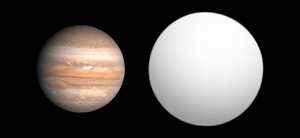HR 8799 c
| Exoplanet | List of exoplanets | |
|---|---|---|
 | ||
| Parent star | ||
| Star | HR 8799 | |
| Constellation | Pegasus | |
| Right ascension | (α) | 23h 07m 28.7150s[1] |
| Declination | (δ) | +21° 08′ 03.302″[1] |
| Apparent magnitude | (mV) | 5.964[1] |
| Distance | 129 ± 4[2][note 1] ly (39 ± 1[2][note 1] pc) | |
| Spectral type | kA5 hF0 mA5 V; λ Boo[3][4] | |
| Observed separation Observation epoch 2008-09-18 | ||
| Angular separation | (ρ) | 964[5][note 2] mas |
| Position angle | (θ) | 317.06[5][note 2]° |
| Projected separation | (d) | 38[5] AU |
| Orbital elements | ||
| Semi-major axis | (a) | ~ 38[5][note 3] AU (~ 5600 Gm) |
| Orbital period | (P) | ~ 190[5][note 3] y |
| Physical characteristics | ||
| Mass | (m) | 7+3 −2[6] MJ |
| Radius | (r) | 1.3[7] RJ |
| Density | (ρ) | 3.2+1.3 −0.7 kg m−3 |
| Temperature | (T) | 1090+10 −90[5] |
| Discovery information | ||
| Discovery date | November 13, 2008 | |
| Discoverer(s) | Marois et al. | |
| Discovery method | Direct imaging | |
| Discovery site | Keck and Gemini observatories in Hawaii | |
| Discovery status | Published | |
| Other designations | ||
| Database references | ||
| Extrasolar Planets Encyclopaedia | data | |
| SIMBAD | data | |
| Exoplanet Archive | data | |
| Open Exoplanet Catalogue | data | |
HR 8799 c is an extrasolar planet located approximately 129 light-years away in the constellation of Pegasus, orbiting the 6th magnitude Lambda Boötis star HR 8799. This planet has a mass between 5 and 10 Jupiter masses and a radius from 20 to 30% larger than Jupiter's. It orbits at 38 AU from HR 8799 with an unknown eccentricity and a period of 190 years; it is the 2nd planet discovered in the HR 8799 system. Along with two other planets orbiting HR 8799, this planet was discovered on November 13, 2008 by Marois et al., using the Keck and the Gemini observatories in Hawaii. These planets were discovered using the direct imaging technique.[5][9][10][11][12] In January 2010, HR 8799 c became the 3rd exoplanet to have a portion of its spectrum directly observed (following 2M1207b and 1RXS J1609b), confirming the feasibility of direct spectrographic studies of exoplanets.[7][13]
Spectra
.jpg)
Near infrared spectroscopy from 995 to 1769 nanometers made with the Palomar Observatory show evidence of Ammonia, perhaps some Acetylene but neither Carbon Dioxide nor substantial Methane.[14] High resolution spectroscopy with the OSIRIS instrument on the Keck Observatory show numerous well resolved lines of molecular absorption in the planet's atmosphere in the K band. Although methane is absent, the planet's atmosphere contains both water and carbon monoxide; the carbon-to-oxygen ratio of HR 8799 c is higher than that of its star, suggesting that the planet formed through the core accretion process.[15][16]
See also
Notes
- 1 2 Computed from parallax:
- 1 2 Calculated from the separations in the East and North directions which are −0.657 and 0.706 arcseconds respectively.
- 1 2 Value given assuming the planet's orbit is circular and is being observed face-on.
References
- 1 2 3 V* V342 Peg -- Variable Star of gamma Dor type, entry, SIMBAD. Accessed on line November 14, 2008.
- 1 2 van Leeuwen, F. (2007). "HIP 114189". Hipparcos, the New Reduction. Retrieved 2008-10-13.
- ↑ Gray, R.O.; Kaye, A.B. (1999). "HR 8799: A Link between γ Doradus Variables and λ Bootis Stars". The Astronomical Journal. 118 (6): 2993–2996. Bibcode:1999AJ....118.2993G. doi:10.1086/301134.
- ↑ Kaye, A.B.; et al. (1999). "Gamma Doradus Stars: Defining a New Class of Pulsating Variables". PASP. 111 (761): 840–844. arXiv:astro-ph/9905042
 . Bibcode:1999PASP..111..840K. doi:10.1086/316399.
. Bibcode:1999PASP..111..840K. doi:10.1086/316399. - 1 2 3 4 5 6 7 Marois, Christian; et al. (November 2008). "Direct Imaging of Multiple Planets Orbiting the Star HR 8799". Science. 322 (5906): 1348–1352. arXiv:0811.2606
 . Bibcode:2008Sci...322.1348M. doi:10.1126/science.1166585. PMID 19008415.
. Bibcode:2008Sci...322.1348M. doi:10.1126/science.1166585. PMID 19008415. - ↑ Marois; Zuckerman; Konopacky; Macintosh; Barman (2010). "Images of a fourth planet orbiting HR 8799". arXiv:1011.4918
 [astro-ph.EP].
[astro-ph.EP]. - 1 2 Jason, M.; C. Bergfors; M. Goto; W. Brandner; D. Lafrenière (2010). "Spatially resolved spectroscopy of the exoplanet HR 8799 c" (PDF). The Astrophysical Journal. arXiv:1001.2017
 . Bibcode:2010ApJ...710L..35J. doi:10.1088/2041-8205/710/1/l35. Retrieved 2010-01-13.
. Bibcode:2010ApJ...710L..35J. doi:10.1088/2041-8205/710/1/l35. Retrieved 2010-01-13. - ↑ HD 218396c -- Extra-solar Planet Candidate, entry, SIMBAD. Accessed on line December 6, 2008.
- ↑ "Astronomers capture first images of newly-discovered solar system" (Press release). W. M. Keck Observatory. 2008-11-13. Retrieved 2008-12-02.
- ↑ "Gemini Releases Historic Discovery Image of Planetary First Family" (Press release). Gemini Observatory. 2008-11-13. Retrieved 2008-12-02.
- ↑ Achenbach, Joel (2008-11-13). "Scientists Publish First Direct Images of Extrasolar Planets". The Washington Post. The Washington Post Company. Retrieved 2008-12-02.
- ↑ Fabrycky; et al. (1 December 2008). "Stability of the directly imaged multiplanet system HR 8799: resonance and masses". Astrophys. J. 710 (2): 1408–1421. arXiv:0812.0011
 . Bibcode:2010ApJ...710.1408F. doi:10.1088/0004-637X/710/2/1408.
. Bibcode:2010ApJ...710.1408F. doi:10.1088/0004-637X/710/2/1408. - ↑ Janson, M. (13 January 2010). "VLT Captures First Direct Spectrum of an Exoplanet". ESO. La Silla Observatory. Retrieved 2010-01-13.
- ↑ B. R. Oppenheimer. "Reconnaissance of the HR 8799 Exosolar System I: Near IR Spectroscopy". Cornell University. arXiv:1303.2627
 . Bibcode:2013ApJ...768...24O. doi:10.1088/0004-637X/768/1/24.
. Bibcode:2013ApJ...768...24O. doi:10.1088/0004-637X/768/1/24. - ↑ Alien planet’s atmosphere contains water and carbon monoxide
- ↑ Giant Alien Planet in Supersized Solar System May Solve Mystery
External links
![]() Media related to HR 8799 c at Wikimedia Commons
Media related to HR 8799 c at Wikimedia Commons
- "HR 8799 c". Exoplanets.
Coordinates: ![]() 23h 07m 28.7150s, +21° 08′ 03.302″
23h 07m 28.7150s, +21° 08′ 03.302″